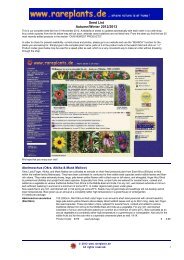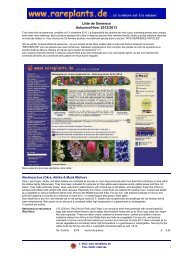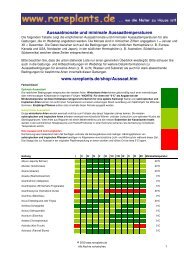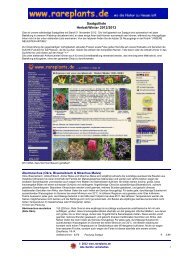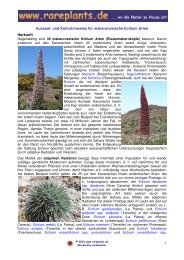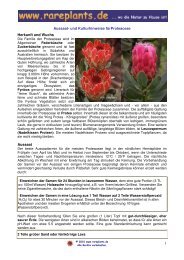Lista de Semillas Otoño/Invierno 2012/2013 - Bjorn Malkmus Rare ...
Lista de Semillas Otoño/Invierno 2012/2013 - Bjorn Malkmus Rare ...
Lista de Semillas Otoño/Invierno 2012/2013 - Bjorn Malkmus Rare ...
You also want an ePaper? Increase the reach of your titles
YUMPU automatically turns print PDFs into web optimized ePapers that Google loves.
Annona (Sour Sack) & Rollinia (Brazilian Custard Apple)<br />
Cherimoya, Sour Sack and Brazilian Custard Apple are evergreen container plants with shiny, dark green foliage. All species have edible<br />
and utmost <strong>de</strong>licious fruits with a very sweet and aromatic white fruit pulp. They are well suited as container plants for any rich, well<br />
drained soil in partial sha<strong>de</strong> to full sun.<br />
Sow at a minimum of some 20°C in any well drained, humus rich soil all year long. Keep pots sunny and soil moist but not wet until seeds<br />
have germinated. Keep cooler and drier at minimum 15°C in winter, always in a sunny spot.<br />
7 semillas por sobre.<br />
Annona cherimola<br />
(Cherimoya)<br />
Annona muricata<br />
(Sour Sack)<br />
Annona reticulata<br />
(Nettled Anón)<br />
Rollinia <strong>de</strong>liciosa<br />
(Brazilian Custard Apple)<br />
Anoda (Anoda Mallow)<br />
2 (3)m, Cherimoya is from the template regions of Colombia, Ecuador and Venezuela. An excellent plant,<br />
growing up to 3 m in height, slightly cold tolerable in autumn. Very sweet and aromatic fruits with white<br />
flesh. Partially sha<strong>de</strong>d to sunny place. Endures slight frost in winter. Zona climática USDA 11.<br />
No. <strong>de</strong> artículo: 2107 sobre <strong>de</strong> semillas<br />
€ 0,79<br />
3 (7)m, Sour Sack from South America, makes the largest fruits in its family, which may gain up to 10kg<br />
in weight! Delicious juices are prepared from its aromatic pulp. For any humus rich, well drained<br />
substrate in a sunny spot throughout the year. In winter keep plants slightly drier at a minimum of some<br />
15°C.<br />
No. <strong>de</strong> artículo: 2128 sobre <strong>de</strong> semillas<br />
€ 0,99<br />
3 (5)m, Nettled Anón is in between Cherimoya and Anón with a very "reptile" like looking skin and a very<br />
sweet pulp. For any humus rich, well drained substrate in a sunny spot throughout the year. In winter<br />
keep plants slightly drier at a minimum of some 15°C.<br />
No. <strong>de</strong> artículo: 2129 sobre <strong>de</strong> semillas<br />
€ 2,49<br />
3 (7)m, Brazilian Custard Apple (syn. Rollinia muscosa) is an evergreen small tree from southern South<br />
America with large foliage and small yellowish-white flowers followed by ornamental, soft-skinned, spiky<br />
yellow fruits with an utmost <strong>de</strong>licious, very sweet white fruit pulp. For any rich, well drained substrate in a<br />
sunny spot throughout the year. In winter months keep plants slightly drier at a minimum of some 15°C.<br />
Seeds are rarely available. V-VII.<br />
No. <strong>de</strong> artículo: 8536 sobre <strong>de</strong> semillas<br />
€ 5,99<br />
Anoda Mallows make up a small genus which is mostly native to Mexico and South America. Most are growing as annuals and have<br />
<strong>de</strong>corative foliage and colourful flowers in rosy sha<strong>de</strong>d followed by disc-shaped seed capsules. Easily grown in any rich well, drained soil<br />
in a sunny spot.<br />
Sow seeds flat in any rich, well drained soil in mid spring. Carefully transplant young plants to the final spot in the gar<strong>de</strong>n as soon as they<br />
are strong enough.<br />
Todas las plantas son <strong>de</strong> la Zona Climática USDA 6.<br />
20 semillas por sobre.<br />
Anoda cristata<br />
(Crested Anoda Mallow)<br />
Anthericum (St. Bernard's Lily)<br />
70 (120)cm, Crested Anoda Mallow is a fast growing annual with several basally branching stems and<br />
showy light blue to pale rose flowers above serrated, heart-shaped, pubescent leaves. It is native of open<br />
spots in meadows throughout central and southern USA. Easily cultivated in any rich, well drained, rather<br />
rocky soil in full sun. Sow directly to the ground in mid spring. VII-IX.<br />
No. <strong>de</strong> artículo: 4766 sobre <strong>de</strong> semillas<br />
€ 2,99<br />
St. Bernard's Lilies are mainly native of Central Europe, the Mediterranean, Asia Minor and Southern Africa. Most species have grass-like<br />
leaves in a basal rosette and racemes with numerous pure white flowers and nicely contrasting yellow to black anthers. Easily cultivated in<br />
any well drained spot in full sun.<br />
Sow autumn to late spring in any well drained, rocky or sandy soil. Keep pots in a sheltered and sunny spot outsi<strong>de</strong> during winter.<br />
Carefully transplant dormant, slightly fleshy rhizomes in early autumn (around mid October).<br />
Todas las plantas son <strong>de</strong> la Zona Climática USDA 6 si no se meciona algo diferente.<br />
20 semillas por sobre.<br />
Anthericum liliago<br />
(St. Bernard's Lily)<br />
Anthericum ramosum<br />
(Branching St. Bernard's<br />
Lily)<br />
Anthocercis (Ray Flower or Tailflower)<br />
40 (70)cm, St. Bernard's Lily is native of mountain slopes in Southern Europe and makes usually solitary,<br />
upright racemes with some 20 (to 50) pure white flowers, each some 1cm in diameter above grass like<br />
leaves in a <strong>de</strong>nse basal rosette. It is a very showy and easily cultivated species for any rich, well drained<br />
soil in a sunny spot. V-VII.<br />
No. <strong>de</strong> artículo: 1200 sobre <strong>de</strong> semillas<br />
€ 2,99<br />
50 (80)cm, Branching St. Bernard's Lily is native of Western and Central Europe. Its habit is similar to the<br />
above. However it is slightly taller with narrower leaves. This species produces more, yet smaller,<br />
perfectly white flowers on strongly branching racemes. Easily cultivated in any sandy or rocky, well<br />
drained soil in a sunny spot. VI-VIII.<br />
No. <strong>de</strong> artículo: 1201 sobre <strong>de</strong> semillas<br />
€ 2,99<br />
Tail Flowers or Ray Flowers belong to a small genus native from dryish soils in Western Australia. They are woody, medium sized to tall<br />
evergreen shrubs with numerous showy star like, white, cream to pale yellow flowers. They are easily grown in pots in any rich, well<br />
drained soil in a sunny spot throughout the year. Keep drier in winter at a minimum of some 10°C.<br />
Sow small seeds on top of any well drained substrate, cover slightly with soil and keep pots in full sun at some 20°C throughout the year<br />
and soil always slightly moist from beneath. A temperature drop at night down to some 10°C to 15°C will significantly enhance germination<br />
in several species.<br />
20 semillas por sobre.<br />
© <strong>2012</strong> www.rareplants.<strong>de</strong><br />
Todos los <strong>de</strong>rechos reservados.<br />
40




